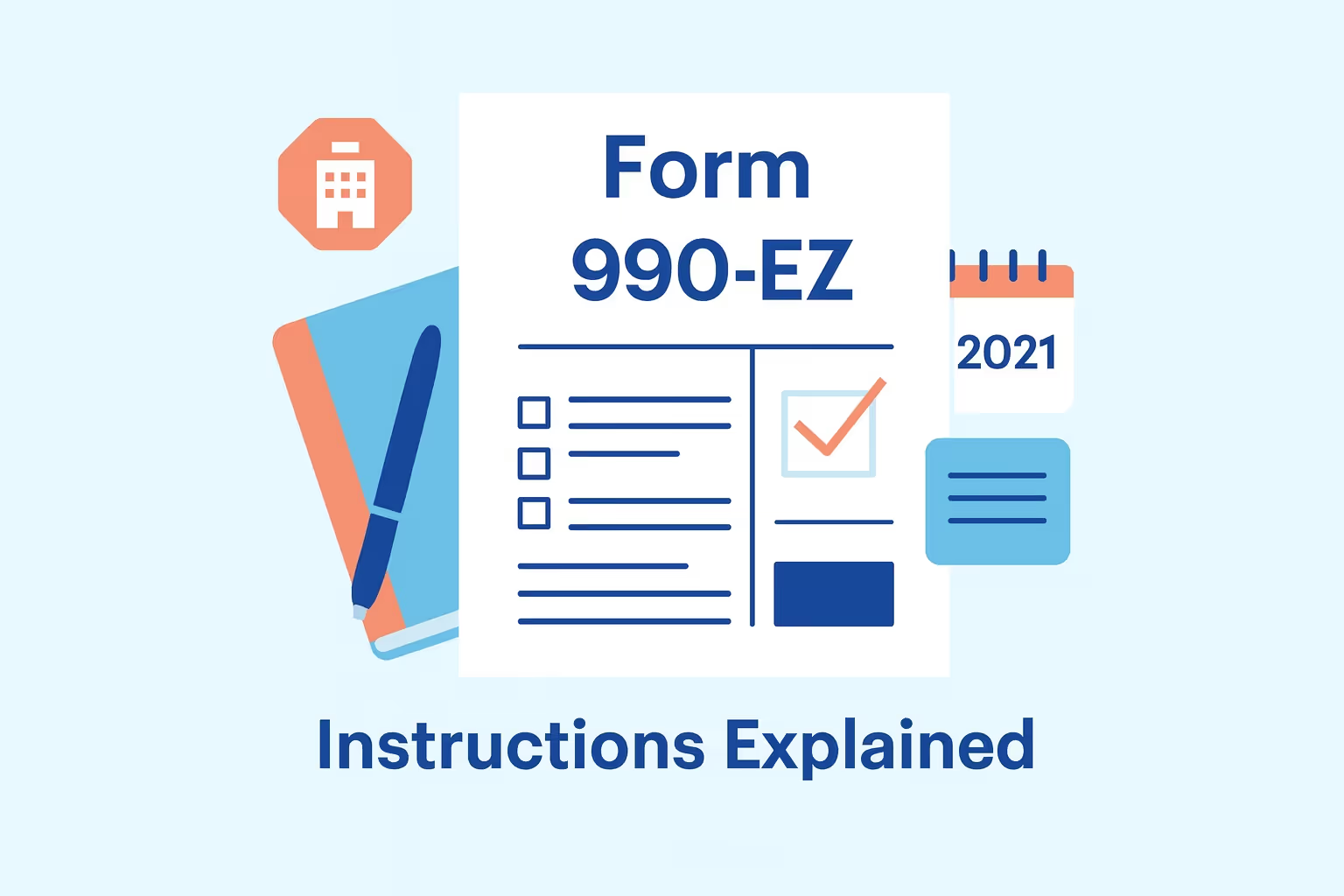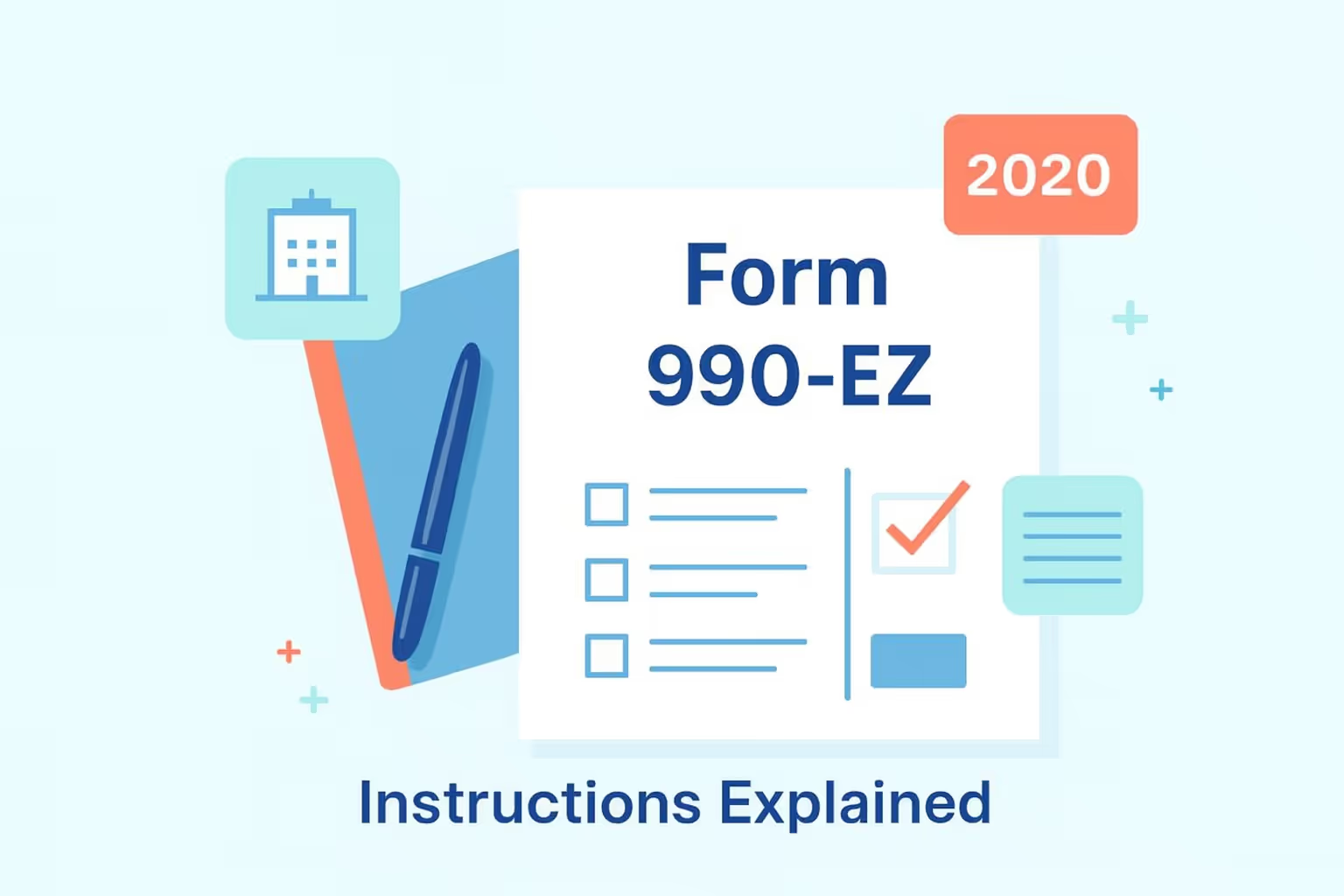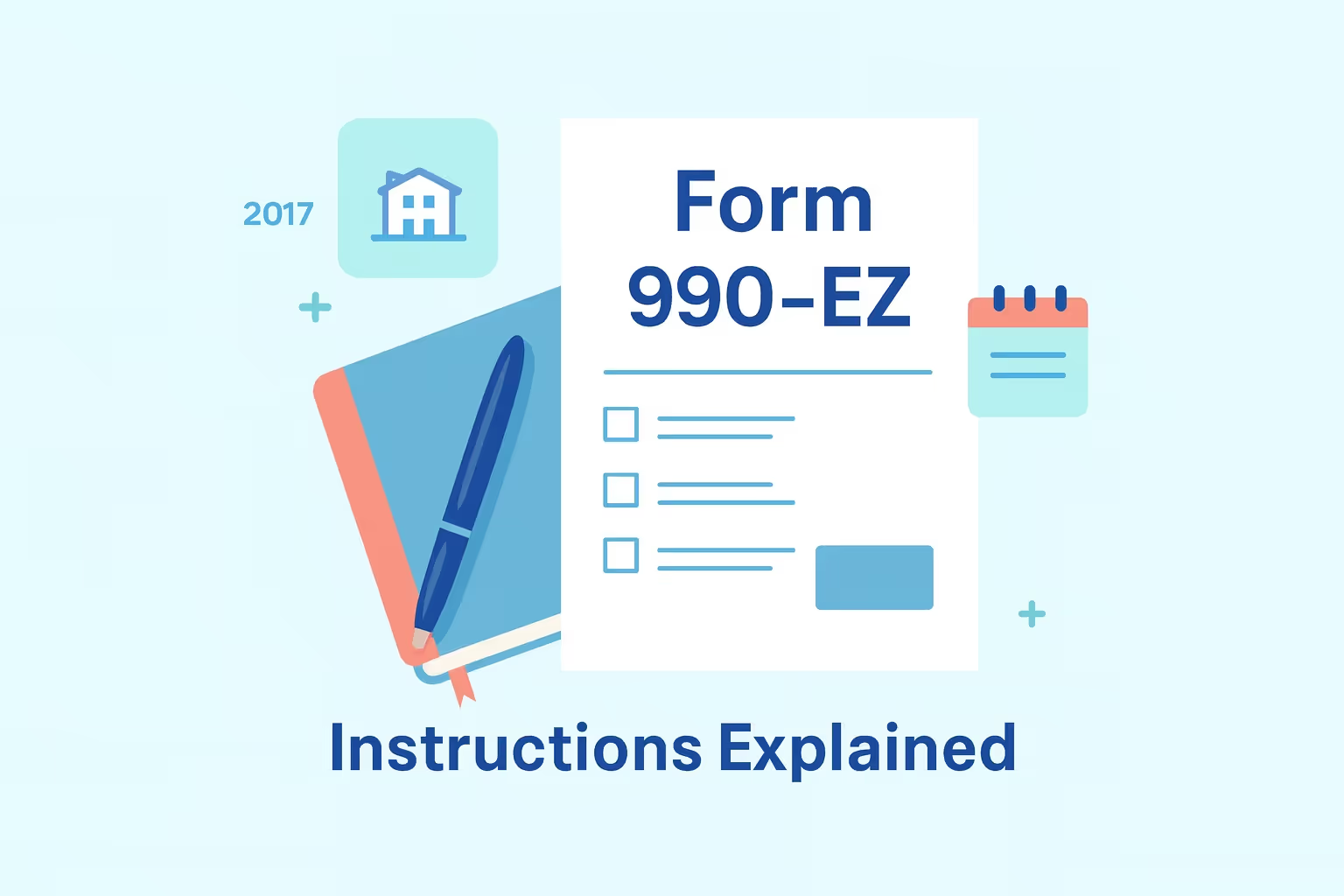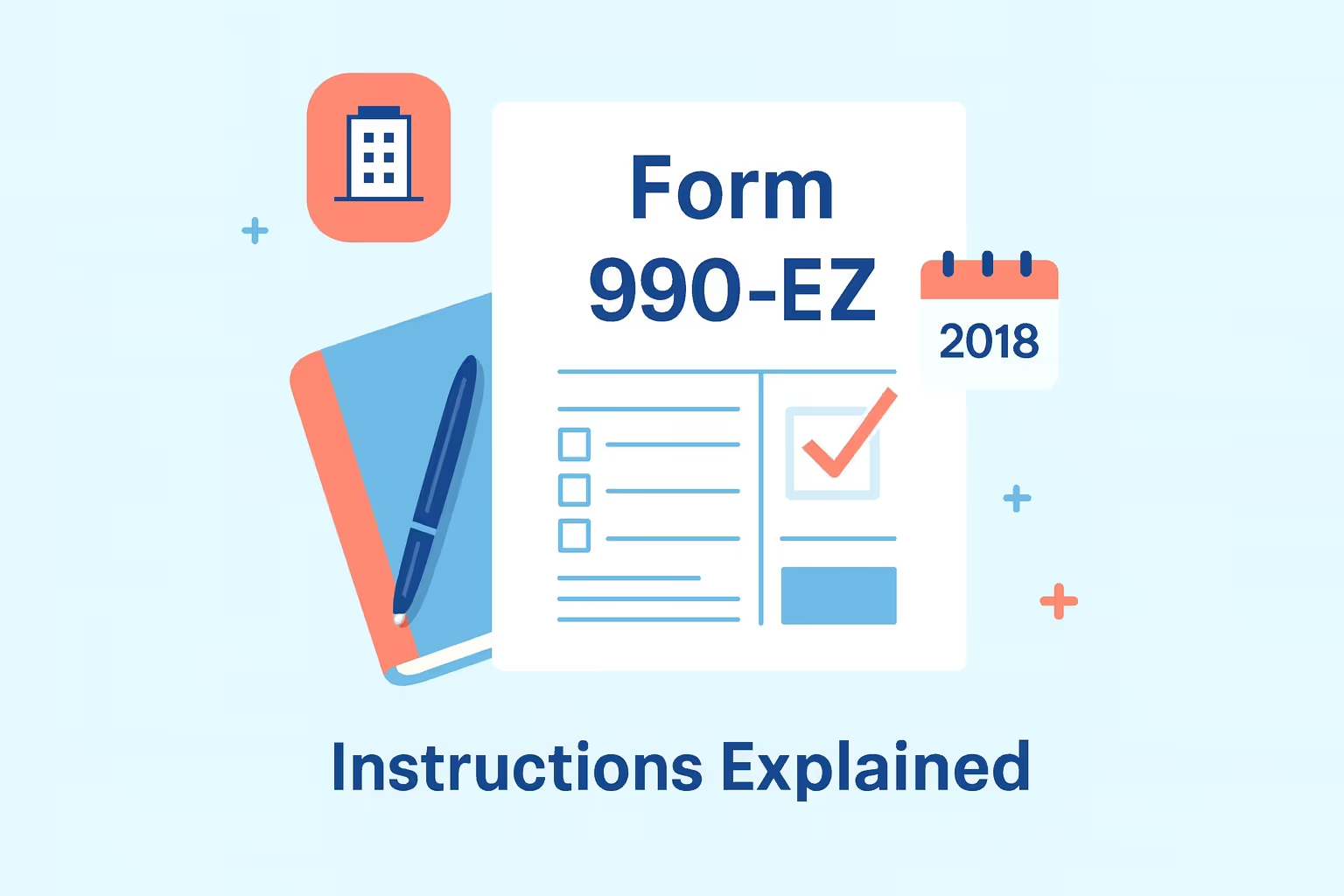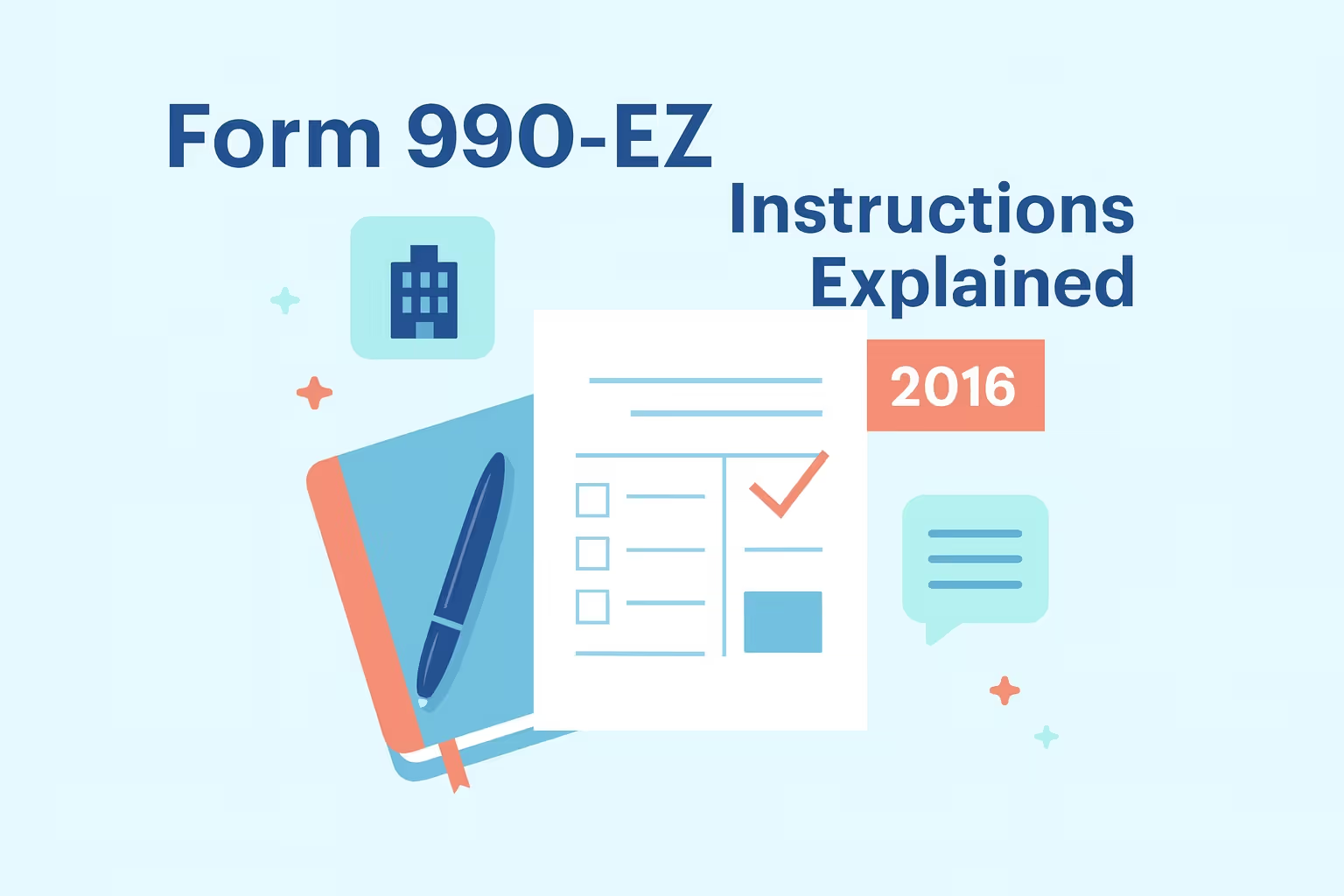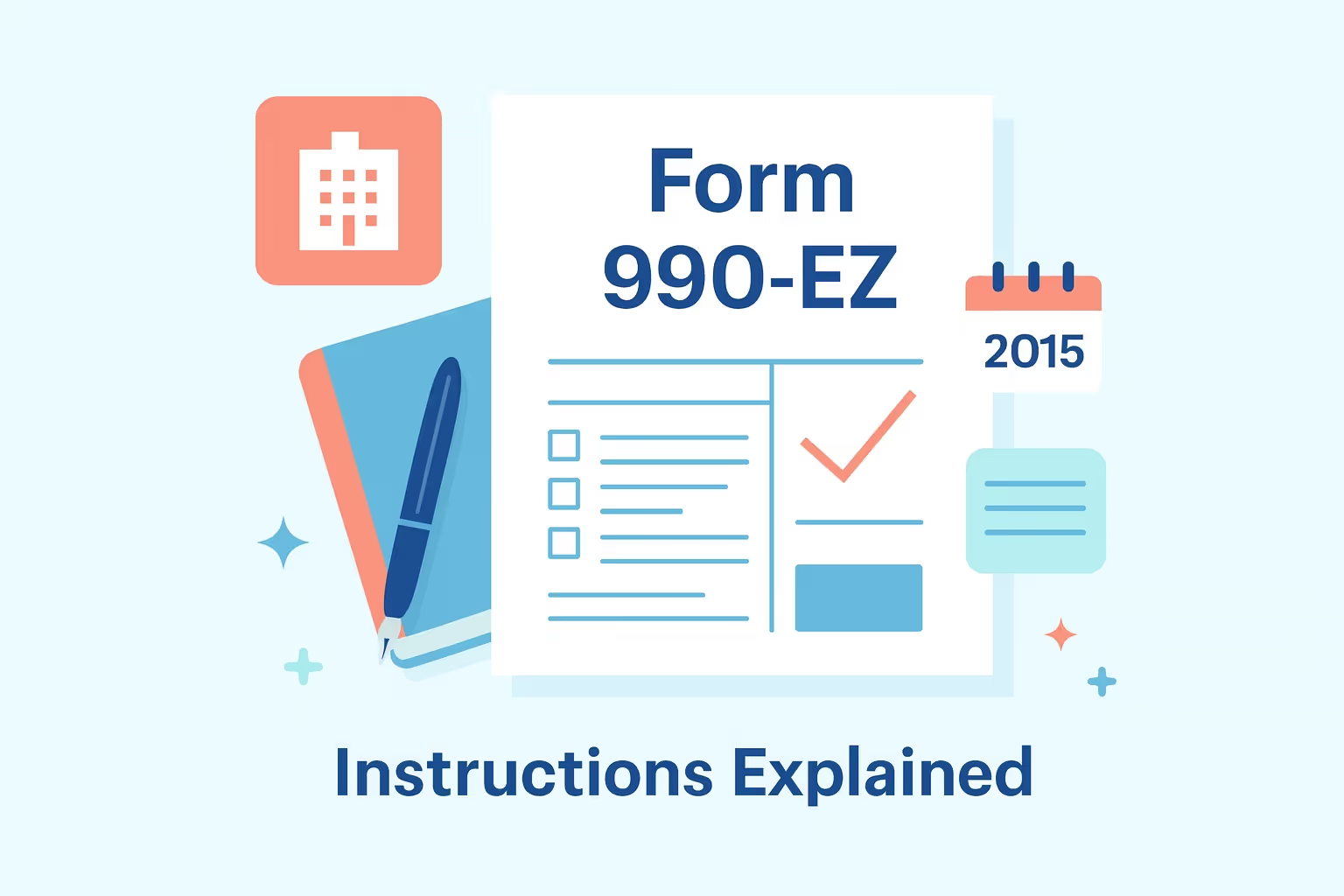How to File Form 990-EZ 2019: IRS Instructions Explained
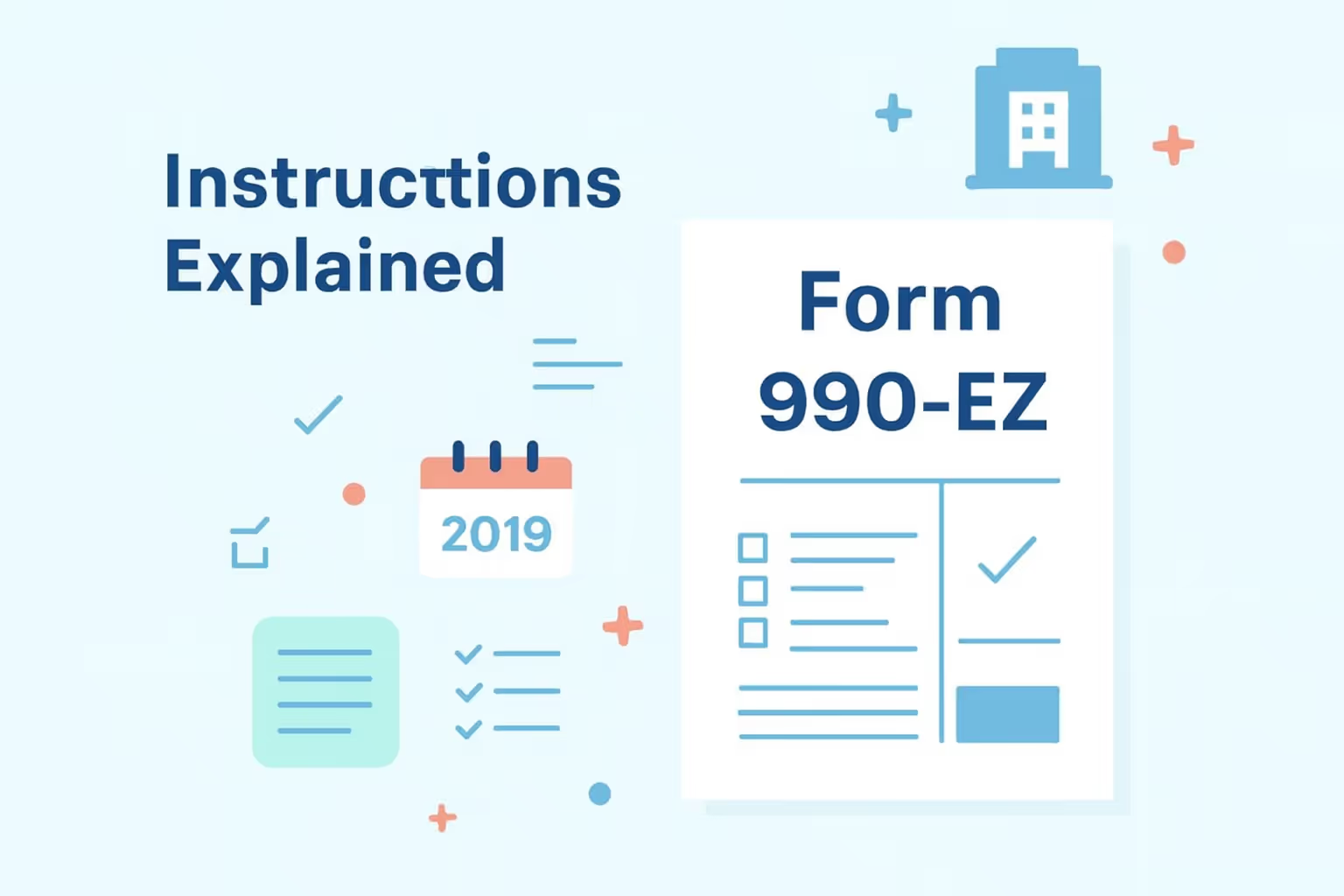
Filing nonprofit tax returns requires careful attention, especially when organizations must meet detailed IRS requirements while maintaining tax-exempt status. For many smaller nonprofit organizations, IRS Form 990-EZ is the most commonly used filing method. This short form allows organizations with smaller income and limited total assets to meet annual reporting requirements without filing the longer Form 990. By following IRS guidance, organizations can maintain compliance and protect their tax-exempt status.
The 2019 tax year introduced significant updates for tax-exempt organizations, including a stronger emphasis on online filing. Understanding which groups qualify, what information must be reported, and how to file electronically is essential. Key details such as the organization’s gross receipts, fiscal tax year, and program service accomplishments determine eligibility and reporting accuracy. Transparent reporting fosters public confidence by showing accountability in nonprofit tax filings.
The IRS Annual Filing and Forms page explains that meeting deadlines is central to maintaining tax exemption and preventing compliance issues. This guide explains the filing process in plain language, highlighting what nonprofit organizations need to prepare, the schedules to attach, and the correct submission process. With these steps, leaders can file confidently and focus on advancing their mission.
Eligibility and Filing Process
Establishing eligibility to file Form 990-EZ requires a thorough understanding of the financial limits and organizational classifications defined under the tax code. Nonprofit organizations must meet strict criteria before using this form. Filing without meeting these qualifications can result in delays or additional reporting requirements, so organizations must confirm eligibility before submission.
Tax Exempt Organizations
Form 990-EZ primarily applies to tax-exempt organizations, such as nonprofit organizations, nonexempt charitable trusts, and specific political organizations. Each group must maintain tax-exempt status by filing accurate reports with the IRS. To qualify, an organization’s gross receipts must remain under $200,000, and its total assets must be below $500,000 at the end of the corresponding tax year. Any organization exceeding these limits must file the longer Form 990.
Organizations Not Eligible
Specific organizations are prohibited from using Form 990-EZ. Private foundations must file Form 990-PF, while sponsoring organizations of donor-advised funds, hospital facilities, and section 501(c)(29) nonprofit health insurance issuers must use other specialized forms. These exclusions require organizations with complex operations to provide more detailed disclosure through comprehensive filings.
Fiscal Tax Year and Calendar Tax Year
The type of accounting year selected also determines eligibility and filing details. Groups following a fiscal tax year file based on the specific start and end dates of their reporting cycle. Organizations using a calendar tax year file for January through December activity. Using the incorrect format can create discrepancies with prior-year filings and raise questions about the accuracy of the submitted data.
Program Service Accomplishments
Eligibility also requires organizations to describe their program service accomplishments accurately. This section of the filing demonstrates how the organization advances its mission and maintains its tax-exempt status. Descriptions should include the nature of the services, the populations served, and the measurable outcomes. Transparent reporting not only fulfills IRS requirements but also builds public trust in the nonprofit sector.
Eligibility rules ensure Form 990-EZ remains a simplified reporting option for organizations with smaller operations. By confirming asset and receipt thresholds, verifying classification, and documenting exempt activities, each nonprofit can determine if this filing process applies. Careful adherence to these requirements preserves compliance and supports transparency across nonprofit tax filing obligations.
Step-by-Step Filing Process
Preparing and submitting Form 990-EZ requires a careful sequence of actions to ensure accurate reporting. Nonprofit organizations with tax-exempt status must collect all necessary details, document their activities, and confirm that every section of the IRS form is complete. Following a structured approach reduces errors and strengthens compliance with federal filing standards.
Step 1: Gather Required Information
Start by collecting the organization’s EIN, accounting records for the fiscal tax year or calendar tax year, and data on program service accomplishments. Include prior year reports to confirm consistency across filings. Maintain documentation for income, expenses, and asset balances, since these records establish eligibility for simplified reporting.
Step 2: Complete Identification Details
Enter the organization’s legal name, mailing address, EIN, and tax year beginning and ending dates. Accurately mark the return type, whether it is an initial form, amended filing, or final submission. This section establishes the framework for the filing process and sets the context for all subsequent entries.
Step 3: Report Revenue and Expenses
Report contributions, grants, program service revenue, membership dues, investment income, and other categories—record expenses such as compensation for key employees, professional services, occupancy, and operational costs. The figures should balance accurately with total assets reported elsewhere on the IRS form.
Step 4: Complete Balance Sheet
Document assets, liabilities, and net assets for both the beginning and end of the tax year. Distinguish between restricted and unrestricted funds where applicable. This part demonstrates the organization’s financial position and helps verify the figures reported in earlier sections.
Step 5: Describe Program Service Accomplishments
Provide clear descriptions of the organization’s exempt activities, noting measurable outcomes and populations served. This section demonstrates compliance with the purpose of tax exemption and validates continued recognition under the tax code. Align descriptions with the organization’s mission and objectives to maintain consistency in reporting.
Step 6: Provide Information on Governance and Other Disclosures
List officers, directors, trustees, and key employees, including hours worked and compensation details. Address additional disclosures by including transactions with interested persons, political campaign activities, or significant disposition of assets. Include all supported schedules as required by IRS rules.
Carefully completing each step ensures an accurate and compliant return. When organizations approach filing in a structured order, they reduce the likelihood of errors, simplify the internal audit check, and build confidence in their nonprofit tax filing process.
File Electronically and Use an Authorized E File Provider
Electronic filing has become the standard process for nonprofit organizations submitting Form 990-EZ, as the IRS increasingly requires organizations to transition away from paper returns. For the 2019 tax year, many groups were expected to file electronically, with transition relief available only for limited circumstances. Using an authorized e-file provider ensures that nonprofit tax filings comply with IRS rules while reducing the likelihood of costly errors.
- File electronically for efficiency: Online filing helps minimize mistakes through built-in validation checks. Organizations also receive electronic confirmation that the IRS accepted the submission, which eliminates uncertainty often associated with mailed returns.
- Authorized e-file provider definition: These providers are third-party platforms or services approved by the IRS to transmit returns. Each provider meets security and compliance standards, making them reliable resources for nonprofit tax filing.
- E-file provider options: Nonprofit organizations may select commercial software, online platforms, or external filing services. They should choose a provider based on organizational needs, prior experience, and the complexity of the filing process.
- Exclusive features for nonprofits: Many platforms include tools that detect missing data, flag inconsistencies, and help reduce filing errors. These safeguards help ensure accuracy when reporting organization details, program service accomplishments, and total assets.
- Support team assistance: Providers often include help desks or online support teams that assist with filing issues. These resources are beneficial when entering lobbying activities, documenting transactions with interested persons, or making adjustments to previously filed data.
- Compliance with electronic filing requirements: Filing through an approved provider aligns with IRS tax code rules. Submitting through unauthorized channels or attempting to bypass e-filing requirements may result in rejection or delays that could impact an organization’s ability to maintain its tax exemption.
Filing electronically with an authorized e-file provider supports accuracy, timeliness, and compliance for nonprofit organizations. By selecting a provider that matches their needs and utilizing built-in validation features, organizations can minimize errors and safeguard their tax-exempt status. This approach ensures smoother nonprofit tax filing while building confidence in each year’s submission.
Required Schedules and Attachments
Form 990-EZ often requires additional schedules to provide context and disclosure about a nonprofit organization’s operations. These attachments ensure the IRS receives a complete picture of the organization’s financial health, governance practices, and compliance with the federal tax code. Each schedule serves a specific purpose, and organizations must carefully determine which ones apply to their filing process.
Why Schedules Are Necessary
Schedules confirm details about contributions, governance, and exempt activities beyond the core form, supporting the accurate reporting of program service accomplishments, transactions with interested persons, and other disclosures necessary for maintaining tax-exempt status. Missing schedules or incomplete responses can delay processing and create compliance challenges for nonprofit organizations.
Key Schedules to Include
- Schedule A – Public Charity Status and Public Support: Required for most section 501(c)(3) organizations, this schedule documents the basis for public charity status and calculates levels of public support. The data confirms that the organization continues to qualify for tax exemption.
- Schedule B – Schedule of Contributors: This schedule applies when an organization receives substantial contributions from a single source. Donors who contribute more than $5,000 or more than 2% of the total contributions must be listed to ensure transparency.
- Schedule C – Political Campaign and Lobbying Activities: Required if the nonprofit engages in lobbying activities or participates in political campaign work. Accurate reporting here protects the organization’s tax-exempt status by demonstrating compliance with the restrictions outlined in the tax code.
- Schedule G – Fundraising and Gaming Activities: Organizations that conduct fundraising events or manage gaming activities such as raffles or bingo must complete this schedule. It provides insight into revenue sources and expenses tied to these activities.
- Schedule O – Supplemental Information: This schedule enables organizations to provide additional information beyond what is provided in the main form or other schedules. It is often used to describe significant disposition of assets, governance policies, or clarifications about financial data.
- Additional schedules when required: Other schedules may apply based on the organization’s operations, including those for schools, foreign activities, or liquidation events. Each must be attached when circumstances match the filing triggers defined in the IRS form.
Organizations can find guidance on which attachments are required and how to prepare them through the IRS Form 990-EZ Instructions, which detail the conditions under which each schedule applies. Including the correct schedules strengthens the accuracy of nonprofit tax filing and demonstrates transparency in both financial reporting and exempt activities.
Due Date and Automatic Extension
Timely filing of Form 990-EZ is crucial for nonprofit organizations to maintain their tax-exempt status. Deadlines vary depending on whether the organization follows a fiscal tax year or a calendar tax year. Understanding due dates and the options available for extensions helps organizations plan and avoid disruptions in compliance.
Standard Filing Deadlines
Nonprofits filing under a calendar tax year must submit their Form 990-EZ by May 15 of the following year. For organizations using a fiscal tax year, the due date falls on the fifteenth day of the fifth month after the end of the reporting period. If the due date lands on a weekend or federal holiday, the deadline shifts to the next business day.
Extension Using Form 8868
Organizations needing more time may request an automatic extension. Filing Form 8868 provides an additional six months to complete and submit Form 990-EZ. The extension applies only to the reporting process and does not cover any tax obligations from unrelated business income reported on Form 990-T. To avoid processing issues, organizations must complete the extension request before the original due date.
Consequences of Missing the Form 990-EZ Filing Deadline
Missing the due date without an approved extension can lead to daily charges for each late day, with maximum amounts determined by the organization’s gross receipts. For nonprofits with gross receipts exceeding $1,067,000, daily amounts are significantly higher. Delays may also result in automatic revocation of tax exemption if the organization fails to file returns for three consecutive years.
Planning Ahead
Organizations should review their filing calendar at the start of each tax year. Establishing an internal audit check early helps confirm required schedules, organization details, and program service accomplishments well before deadlines approach. Many organizations prepare draft filings months in advance to ensure accuracy and leave time for review by paid preparers or board members.
Filing on time preserves transparency and protects nonprofit organizations from unnecessary compliance risks. By tracking deadlines carefully and utilizing automatic extensions when necessary, organizations maintain stability in their tax filings while demonstrating a continued commitment to tax-exempt operations.
Cost Corrections and Common Errors
Nonprofit organizations filing Form 990-EZ must review every section carefully before submission. Errors in Form 990-EZ filings can result in additional administrative costs, delayed processing, or IRS inquiries into the organization’s tax-exempt status. A structured review of common mistakes and the necessary actions to correct them enables organizations to file with greater confidence and accuracy.
Steps to Avoid and Correct Common Filing Issues
- Verify mathematical accuracy: Ensure that totals for revenue, expenses, and assets add correctly across the form. Differences between sections may trigger an IRS inquiry or require corrections after submission.
- Review organization details: Confirm the accuracy of the legal name, EIN, and reporting period. Incorrect information in these fields can cause records to mismatch with previously filed returns, resulting in processing delays and errors.
- Check program service accomplishments: Describe exempt activities with measurable outcomes. Incomplete or vague responses may weaken the organization’s case for maintaining tax exemption and can result in IRS requests for supplemental information.
- Confirm schedules and attachments: Include all required schedules, such as Schedule A for public charity status or Schedule B for substantial contributors. Missing schedules often result in filings being considered incomplete.
- Audit compensation reporting: List all compensation paid to key employees, officers, and directors. Underreporting or omitting amounts creates compliance risks and may require amended filings to correct errors.
- Validate balance sheet entries: Ensure that the sum of assets equals the sum of liabilities and net assets. Mistakes in this section raise concerns about internal record-keeping and often require cost corrections following an IRS review.
- Review disclosures for political campaign or lobbying activities: If the organization engaged in these activities, complete Schedule C accurately. Incorrect disclosures may impact the organization’s standing as an entity exempt from taxation under the tax code.
- Confirm consistency with prior-year filings: Compare current-year data to earlier returns. Significant, unexplained changes in income or expenses can lead to additional questions and delay acceptance of the return.
Cost corrections and error prevention strategies provide nonprofit organizations with a framework for accurate reporting. By following structured steps and conducting a thorough internal audit check before submission, organizations can minimize risks and protect their tax-exempt status. Reliable nonprofit tax filing demonstrates accountability, strengthens public trust, and ensures smoother interactions with the IRS.
Internal Audit Check and Best Practices
Nonprofit organizations benefit from conducting an internal audit check before submitting Form 990-EZ. This process enhances accuracy, identifies data gaps, and ensures the return accurately reflects the organization’s operations. By building audit steps into the filing process, organizations demonstrate accountability while reducing the risk of corrections or compliance issues after submission.
Conducting an audit involves reviewing financial records, program service accomplishments, and governance practices. Each detail must align with the requirements of the IRS form, including total assets, income, and organization details. A consistent review process also helps identify errors from prior-year filings and ensures the accurate disclosure of transactions with interested persons.
Key Elements of an Internal Audit Check
- Reconcile financial data: Compare reported income and expenses with financial statements to verify accuracy. Discrepancies can create problems during IRS review and may require amendments.
- Validate governance reporting: Confirm that board members, key employees, and officers are accurately reported, with correct compensation figures and hours worked.
- Review program service accomplishments: Ensure descriptions are specific, measurable, and aligned with the exempt purpose that supports the organization's tax-exempt status.
- Check supported schedules: Verify that all required schedules, including those for public support, political campaign activities, or fundraising events, are attached and consistent with main form entries.
- Test consistency with prior filings: Examine whether figures from the current tax year align with trends from earlier returns. Significant unexplained changes often invite further review.
- Assess disclosure of special transactions: Confirm that significant disposition of assets, gaming activities, or related-party transactions are adequately documented.
Establishing best practices for nonprofit tax filing goes beyond the internal audit itself. Organizations should assign clear responsibilities among staff and board members for recordkeeping and review. Engaging an independent reviewer or a different provider for complex sections can strengthen compliance and improve accuracy. Maintaining organized data systems also enhances efficiency in annual filings and supports long-term transparency.
By prioritizing internal audit checks and adopting best practices, nonprofit organizations can improve the accuracy of their IRS Form 990-EZ. A thorough review demonstrates a commitment to sound governance, financial stewardship, and compliance with the tax code. This approach protects the organization’s tax-exempt status, reinforces credibility with donors, and ensures smoother nonprofit tax filing year after year.
Frequently Asked Questions
What are the eligibility requirements for filing Form 990-EZ 2019?
Organizations may file Form 990-EZ 2019 if their gross receipts are under $200,000 and total assets are below $500,000 at the end of the tax year. This simplified form is designed for nonprofit organizations with smaller operations. Groups exceeding these thresholds must file the complete Form 990. Maintaining accurate organizational details and documenting program service accomplishments are essential for preserving tax-exempt status when using the short form return.
Can nonprofit organizations file electronically for Form 990-EZ?
Yes, nonprofit organizations may file electronically through an authorized e-file provider. Filing electronically reduces errors, provides quicker confirmation, and ensures compliance with the IRS requirement for online filing in certain tax years. Organizations should select an e-file provider that offers support and validation features to provide accurate and timely filing. Electronic filing also simplifies cost corrections by catching missing or inconsistent data before the IRS processes the nonprofit tax filing submission.
What schedules must accompany Form 990-EZ?
Required schedules depend on the organization’s activities and classification. For example, Schedule A reports public charity status and public support, while Schedule B lists substantial contributors. Schedule C applies if the nonprofit engaged in political campaign or lobbying activities, and Schedule O provides supplemental information. Including the correct supported schedules strengthens compliance, ensures accurate reporting of program service accomplishments, and reinforces the organization’s ongoing recognition as an entity exempt under the tax code.
What is the due date for filing Form 990-EZ?
For organizations using a calendar year for tax purposes, the due date is May 15 of the following year. For fiscal tax year filers, the deadline falls on the fifteenth day of the fifth month following the end of the reporting period. Organizations may request an automatic extension by filing Form 8868. Timely filing preserves nonprofit tax compliance and prevents complications that could affect the organization's tax-exempt status with the IRS.
How should nonprofit organizations handle cost corrections?
Nonprofits must review Form 990-EZ carefully to avoid cost corrections related to mathematical errors, missing data, or incomplete schedules. Common issues include unbalanced totals on the balance sheet, underreporting compensation for key employees, or failing to include required information about interested persons. Conducting an internal audit check before submission reduces these risks. Addressing errors promptly ensures accurate nonprofit tax filings and protects the organization’s tax-exempt status under federal reporting requirements.
Can small nonprofit organizations use the e-postcard option?
Yes, organizations with gross receipts of normally $50,000 or less may use the electronic postcard, known as Form 990-N. This e-filing option requires only basic details such as the organization’s EIN, legal name, and tax year beginning and ending dates. Filing the e-postcard fulfills annual reporting obligations for smaller nonprofits, helping them maintain tax-exempt status while reducing administrative burden. It serves as a simpler alternative to the more detailed IRS Form 990-EZ.
What best practices improve accuracy in nonprofit tax filing?
Best practices include conducting an internal audit check, reconciling financial data with organizational records, and ensuring supported schedules match reported amounts. Organizations should confirm that program service accomplishments reflect exempt activities and verify compensation data for key employees. Using an authorized e-file provider strengthens compliance by preventing standard errors. Following these practices helps nonprofit organizations maintain tax-exempt status, complete the filing process accurately, and demonstrate accountability in their operations.
















